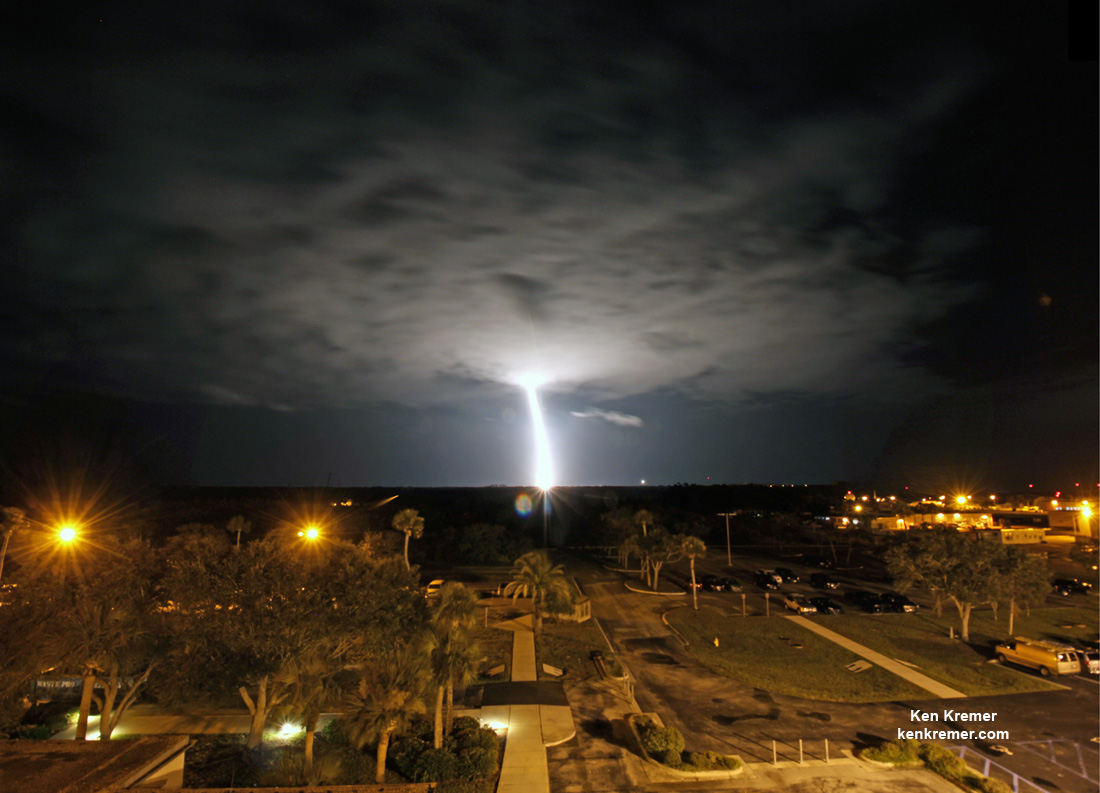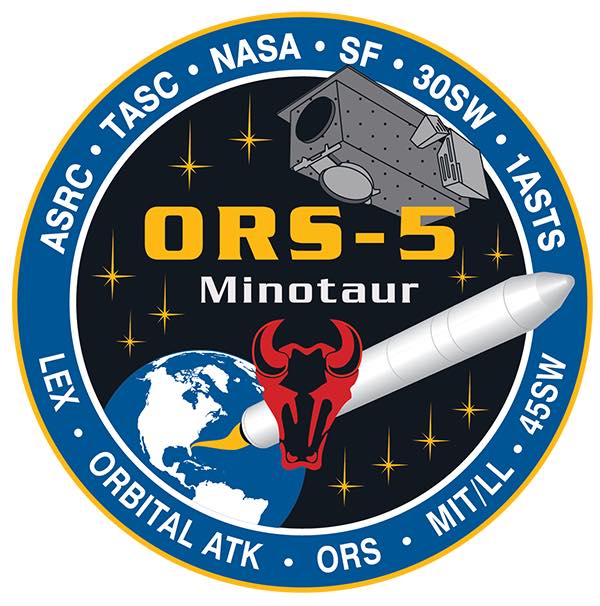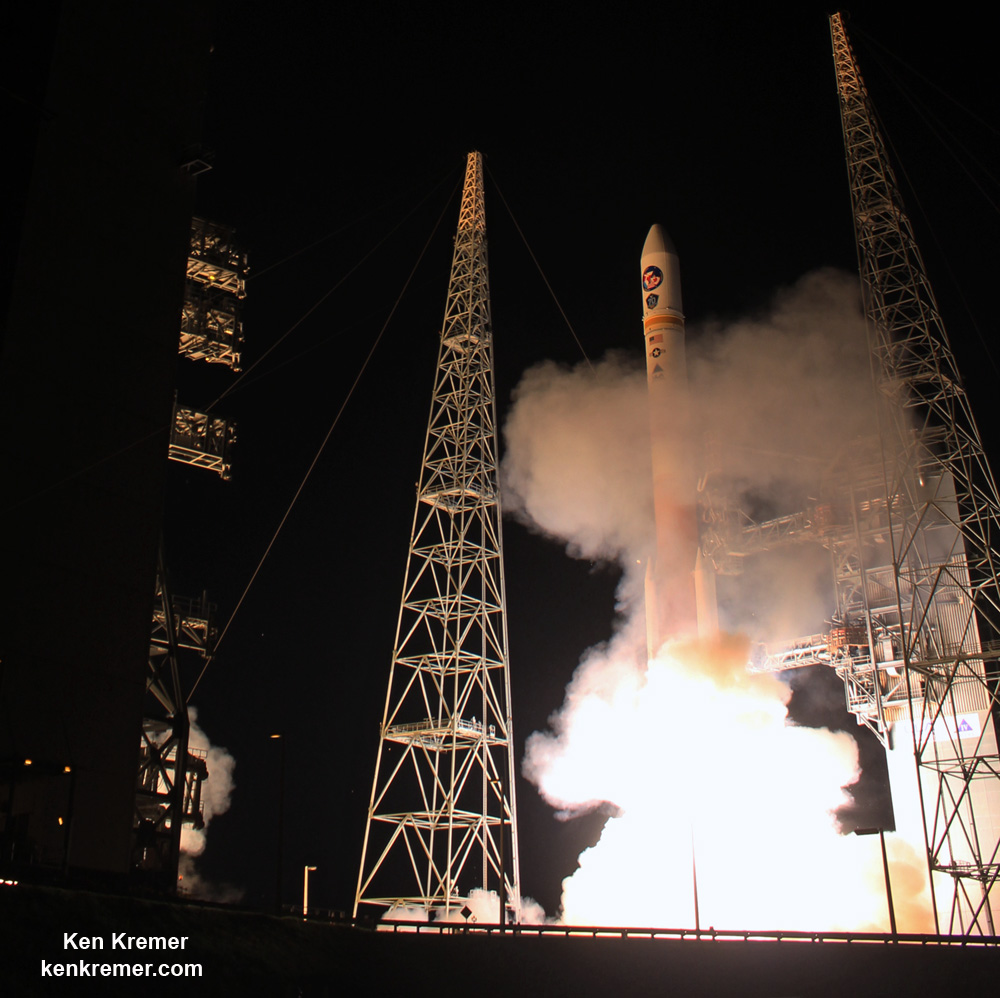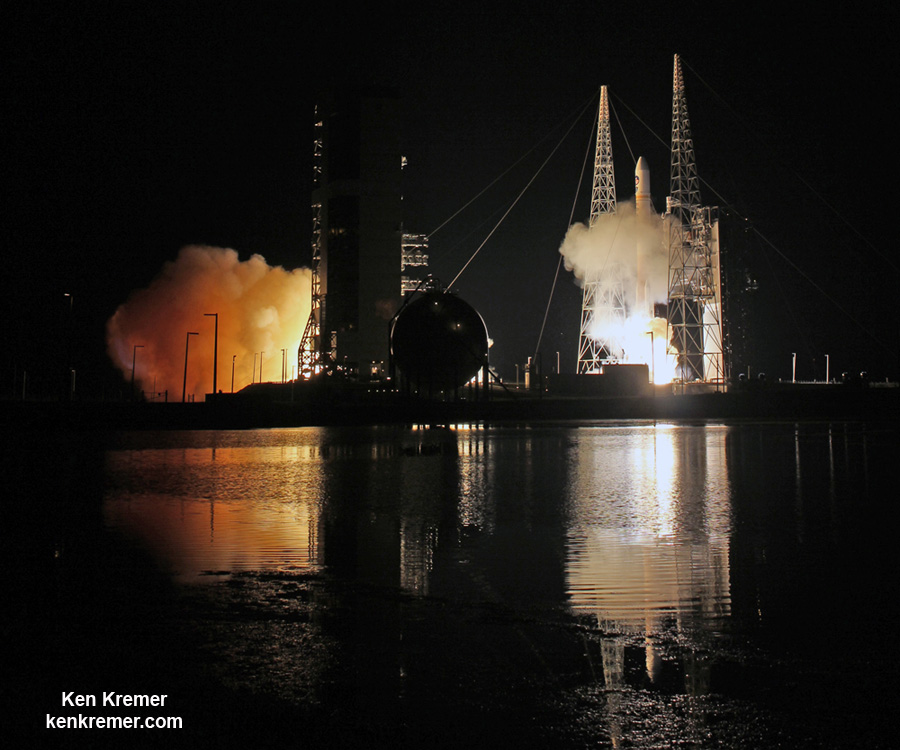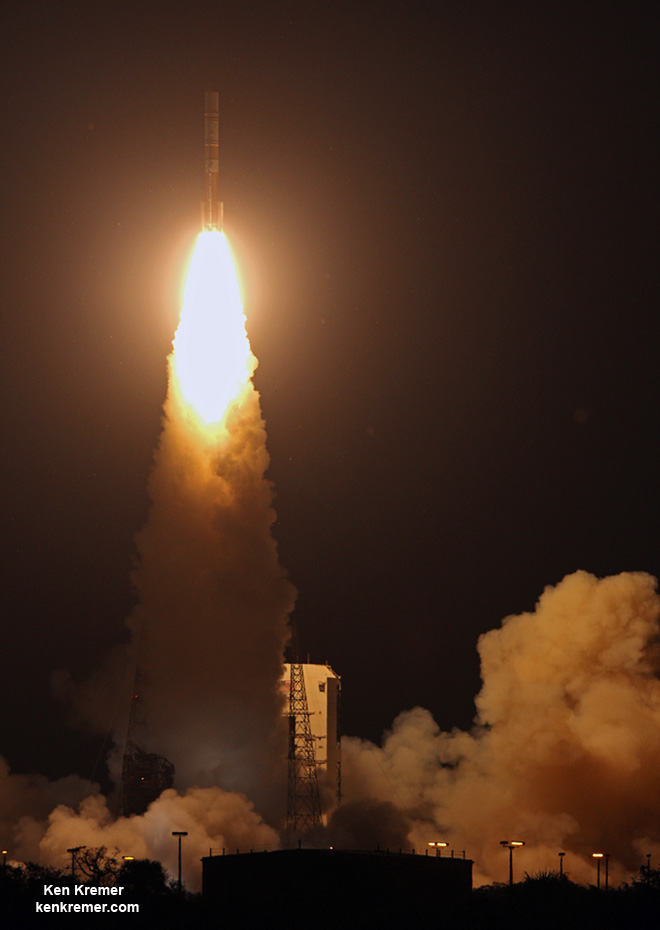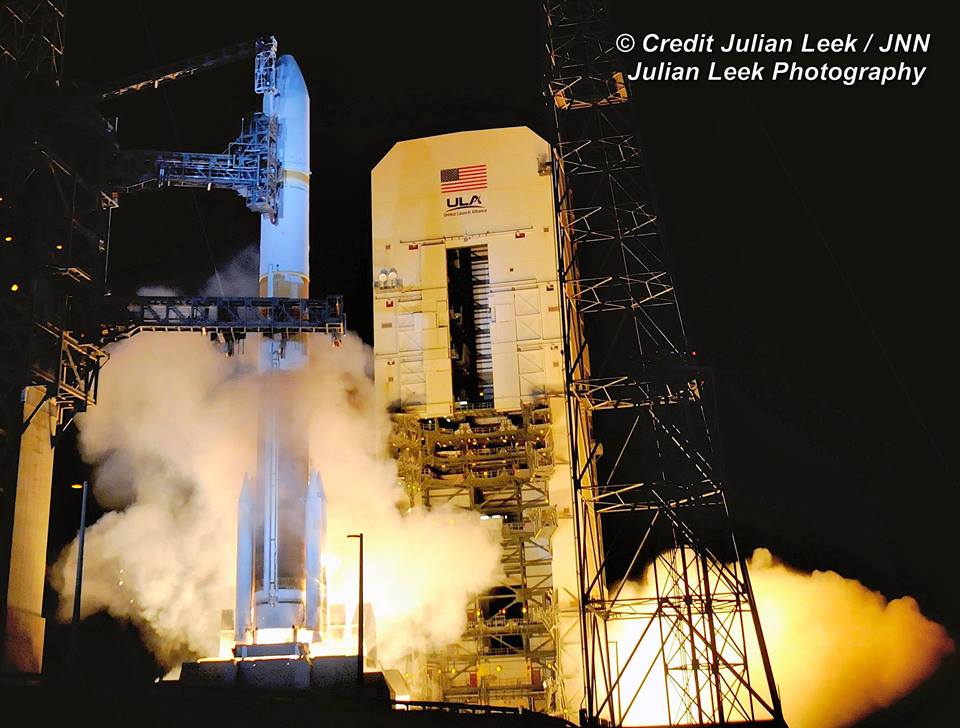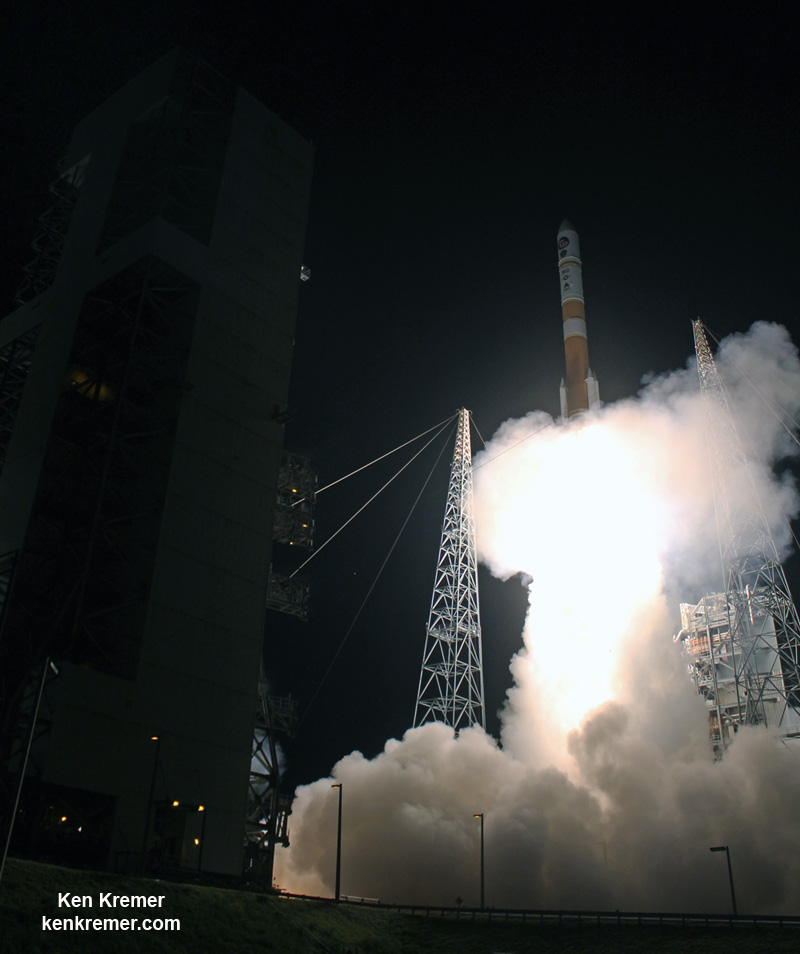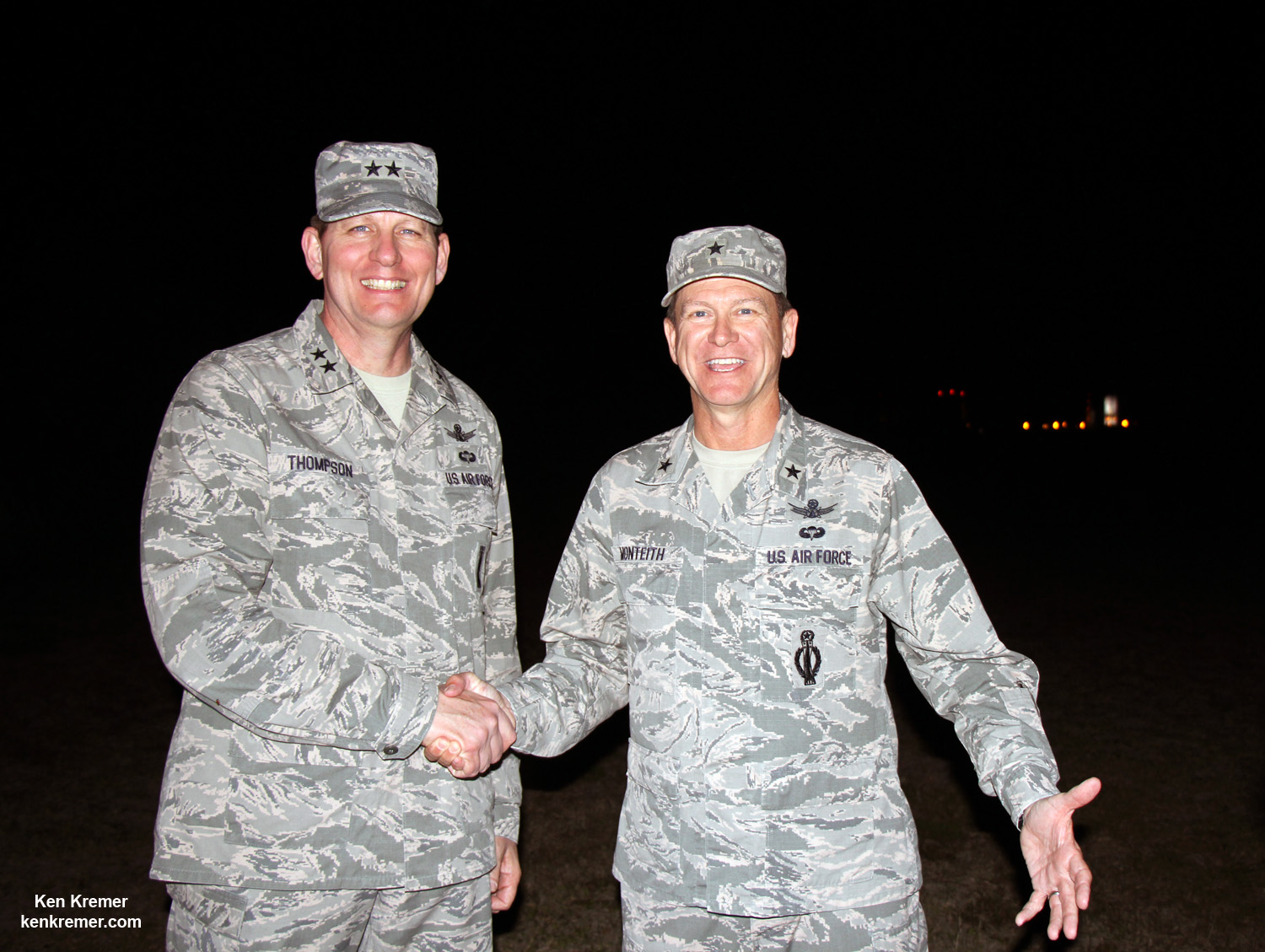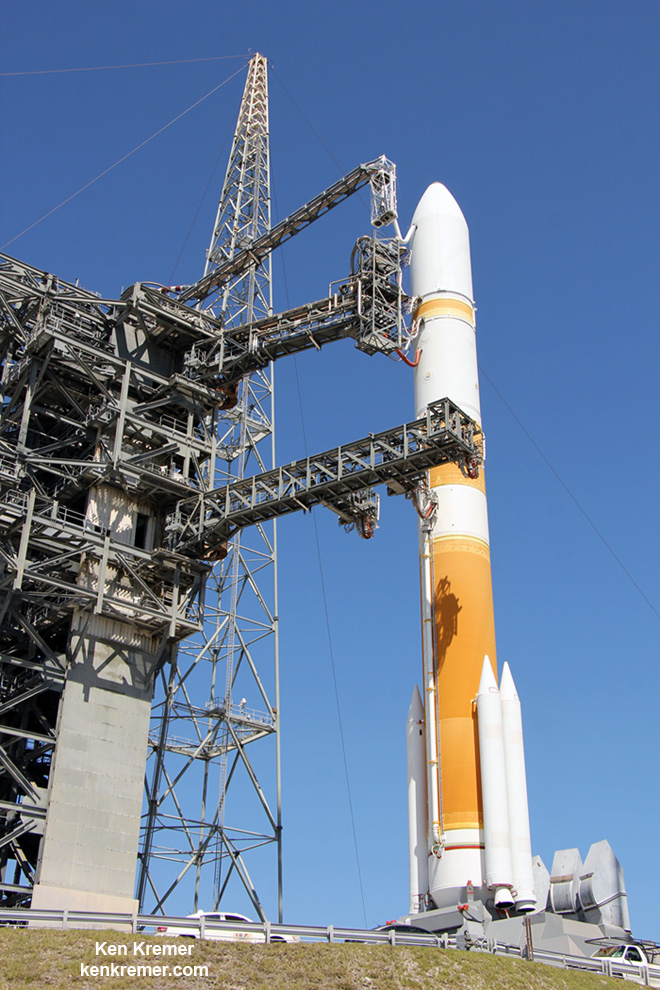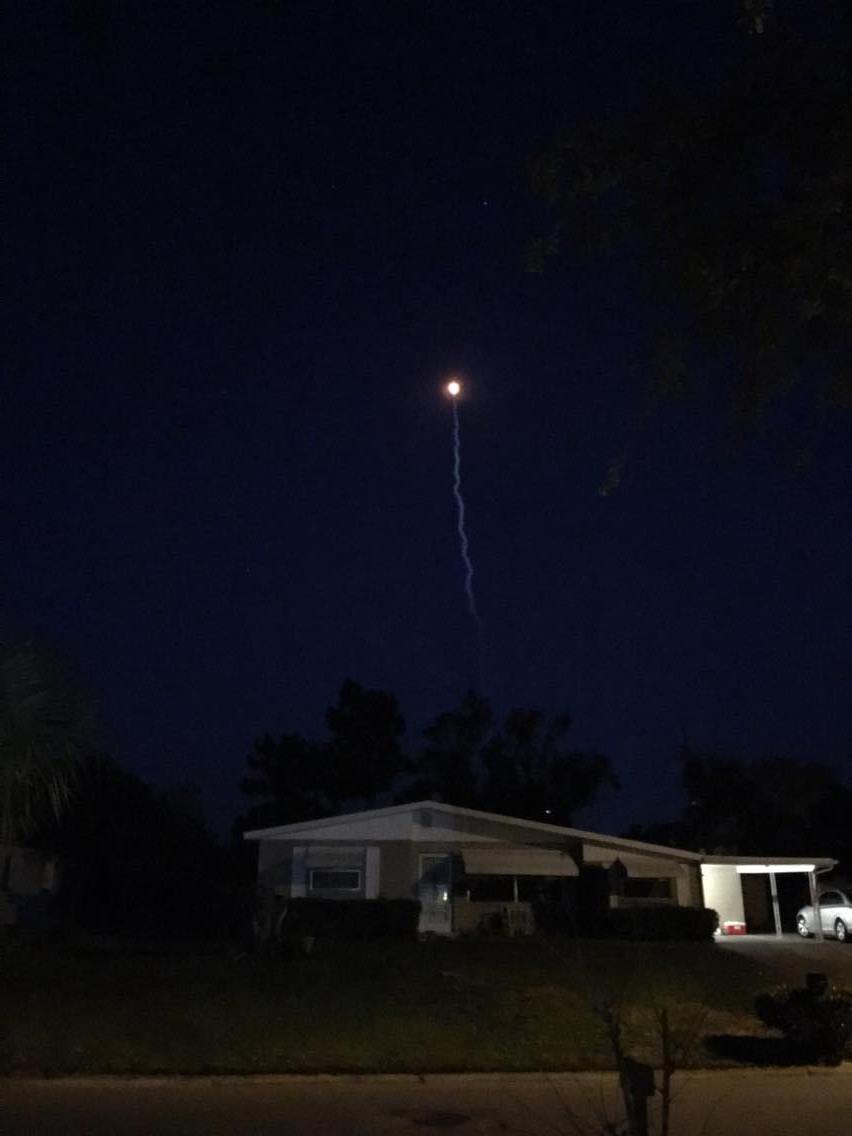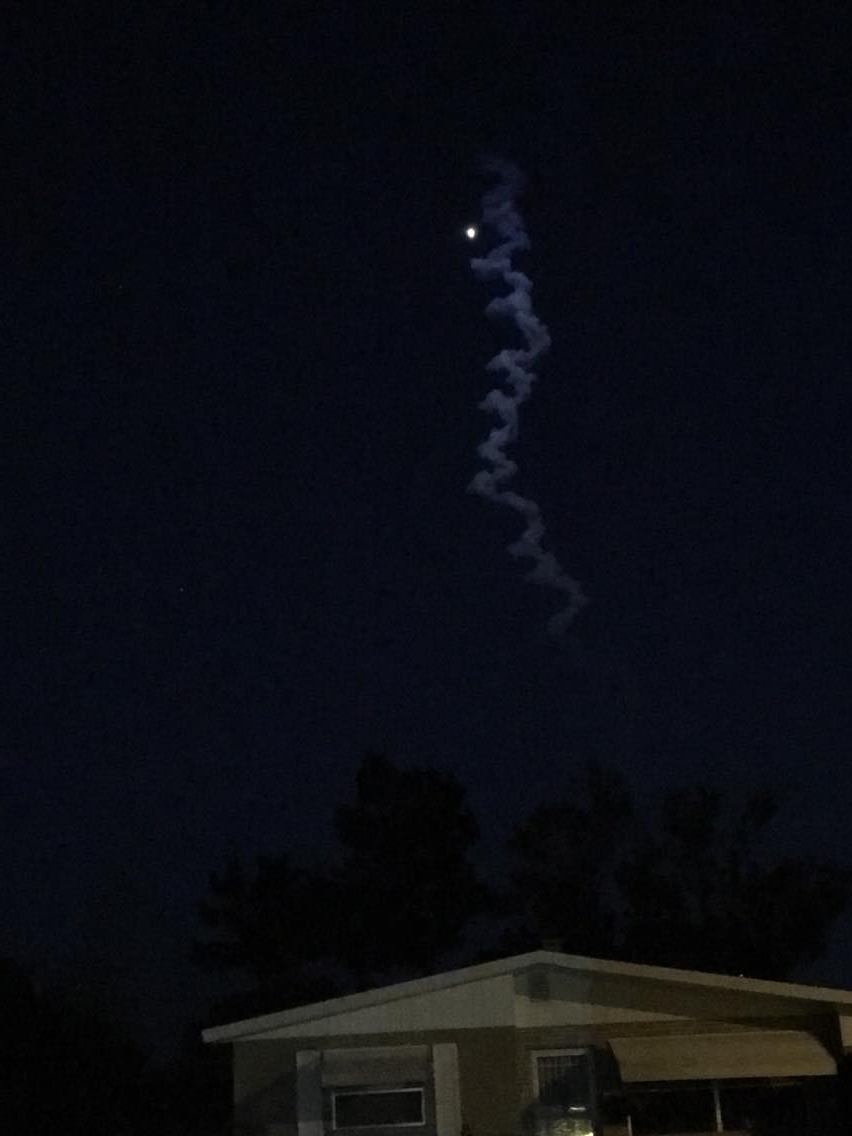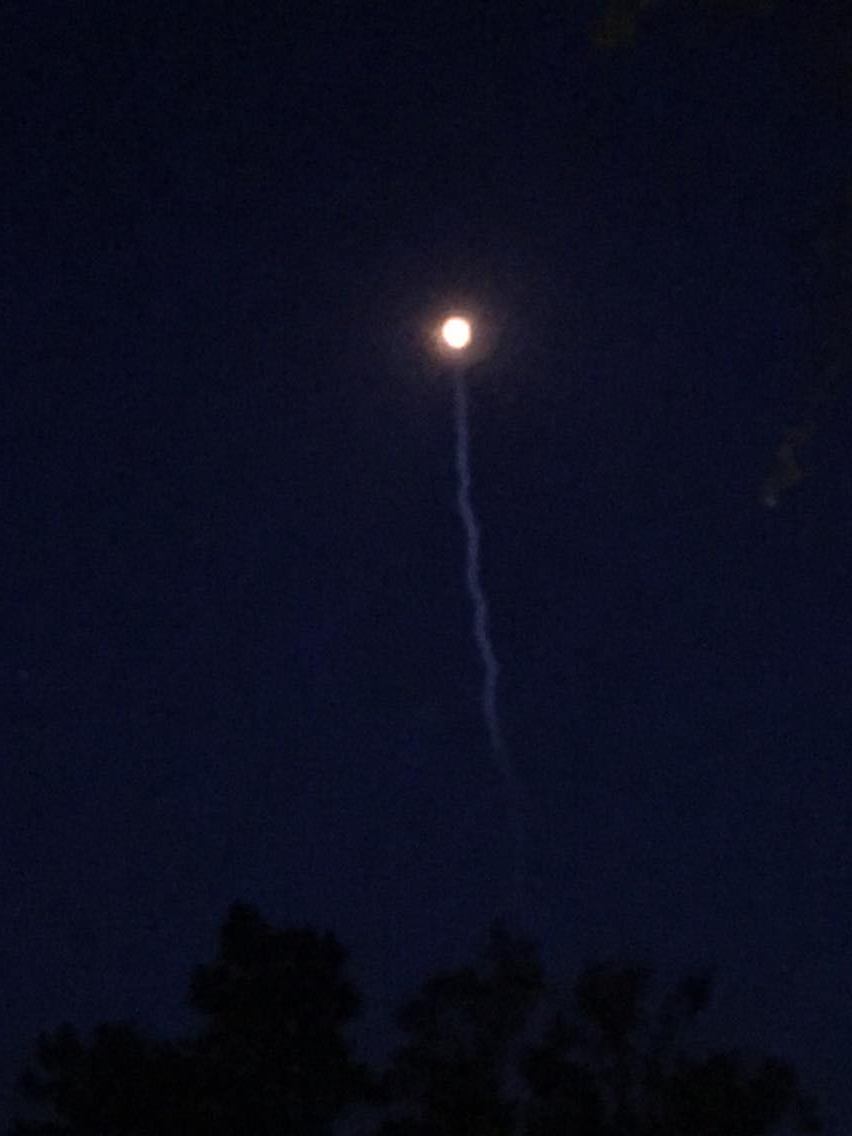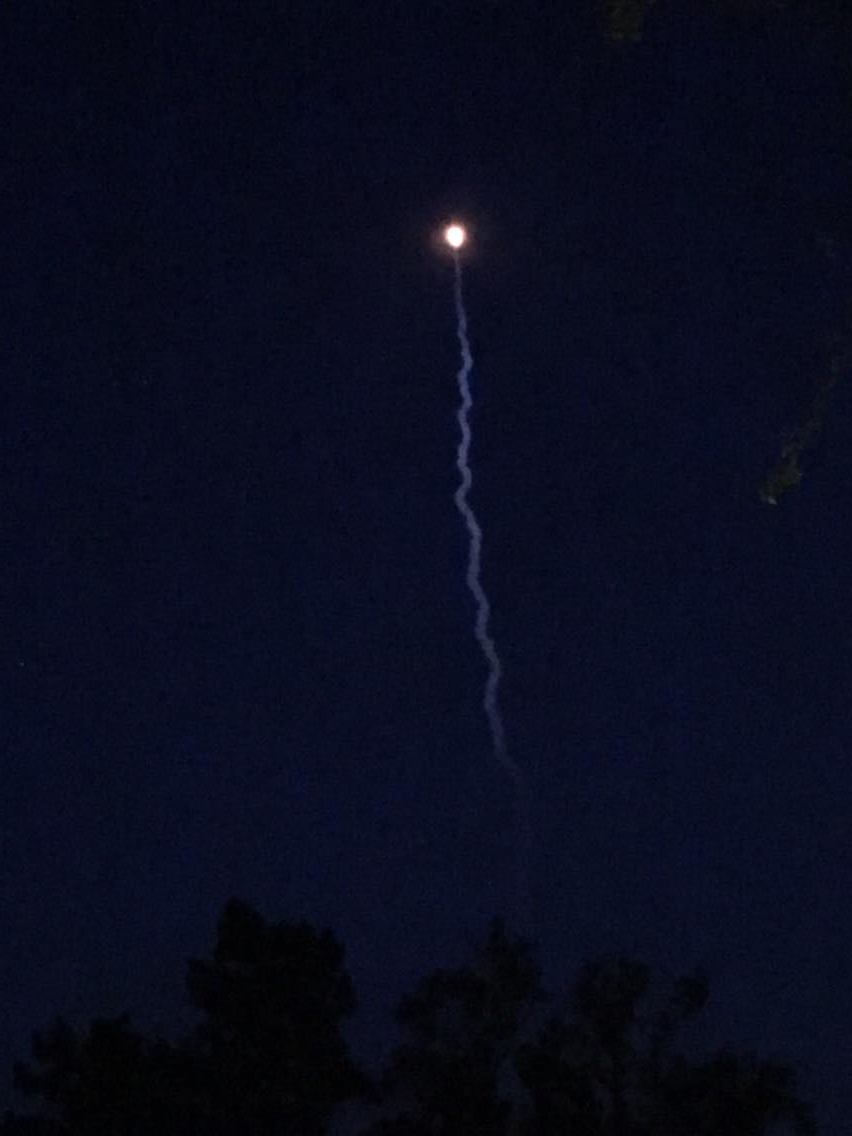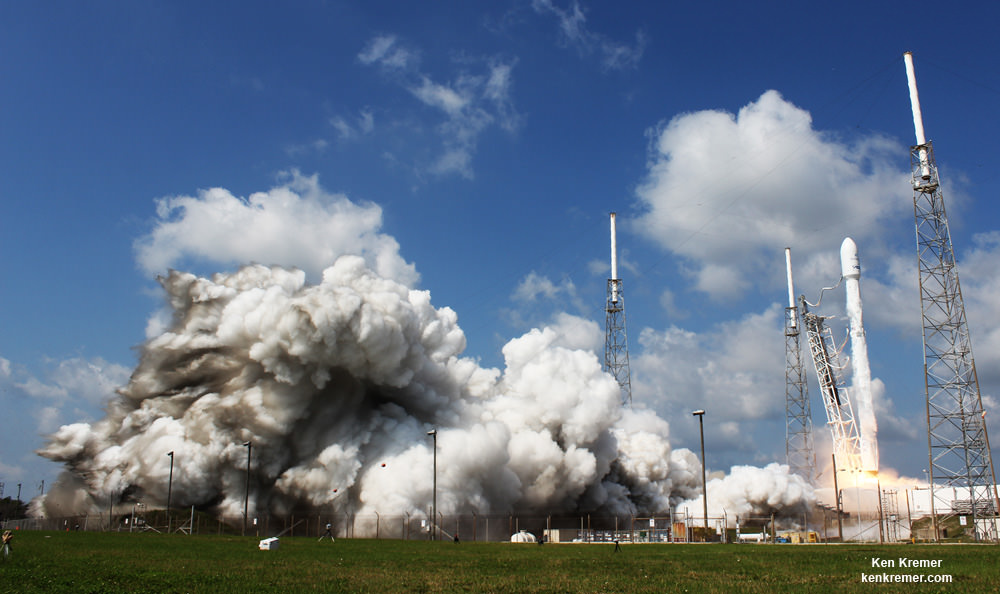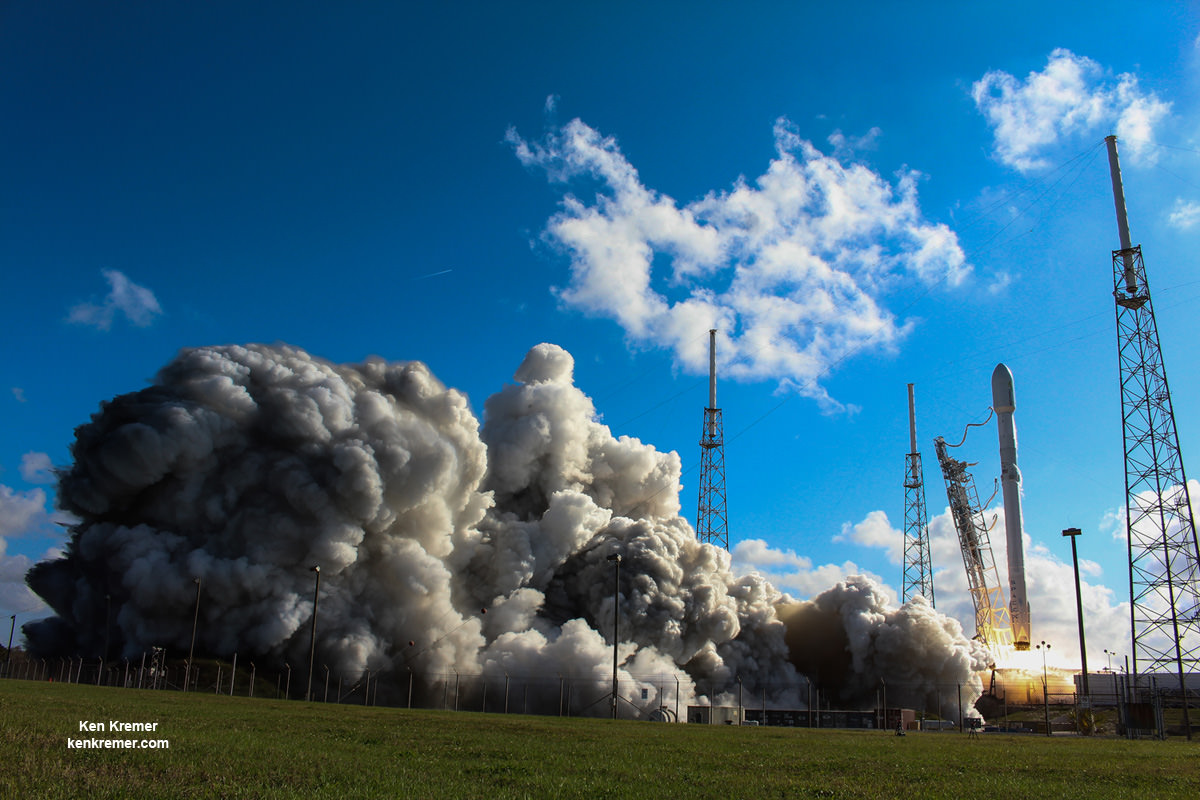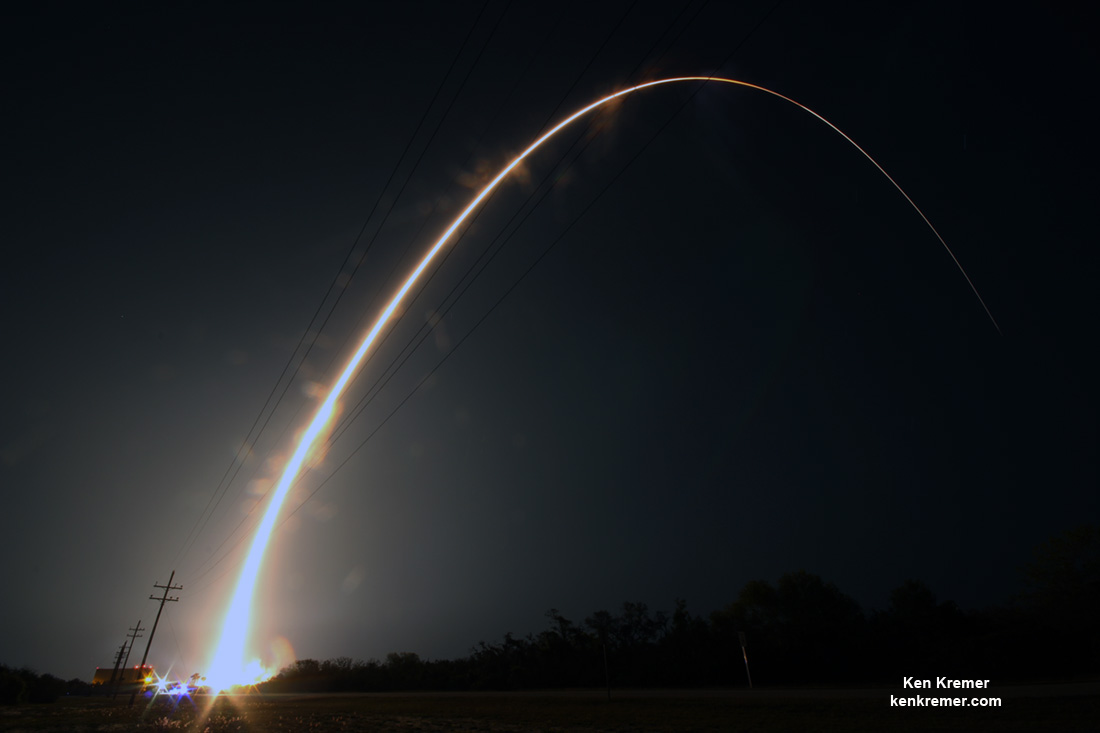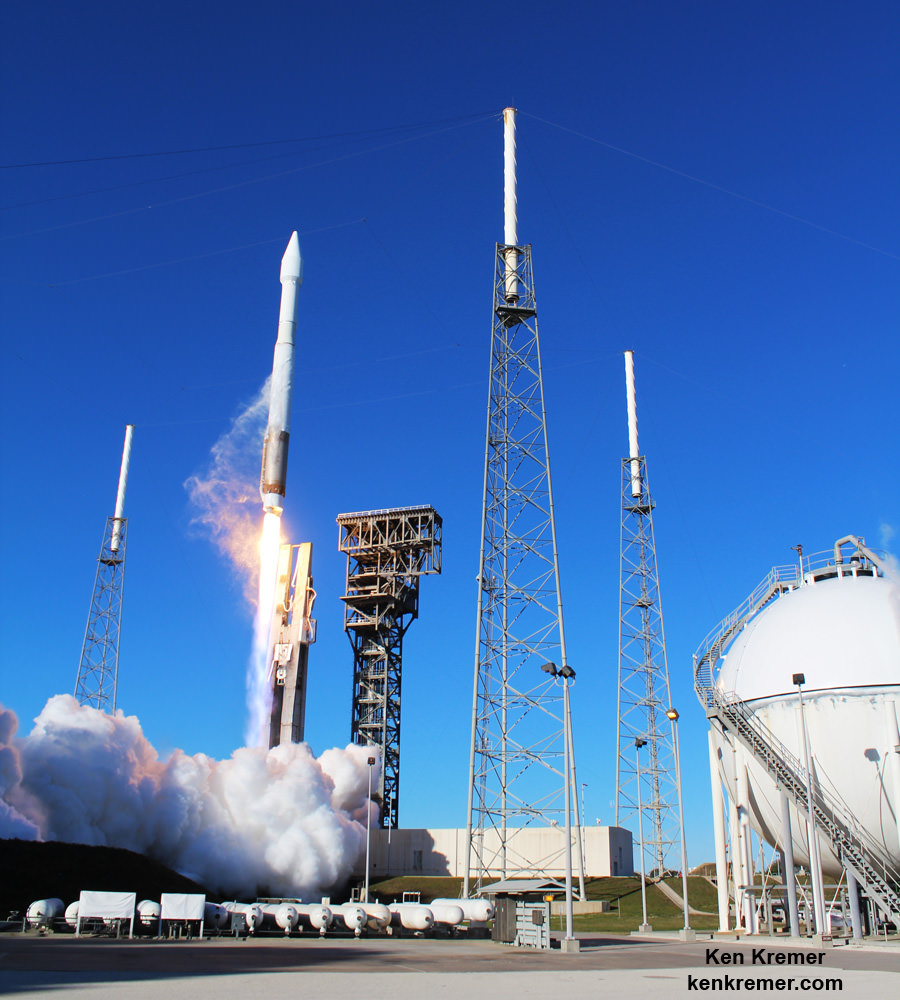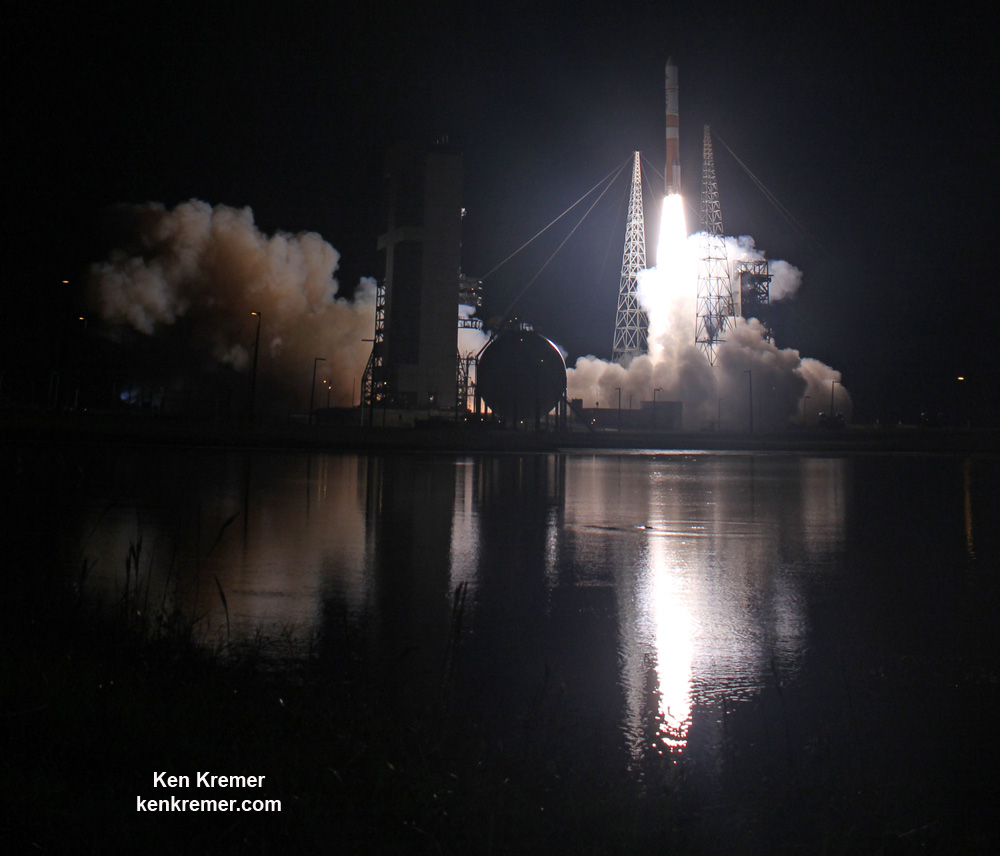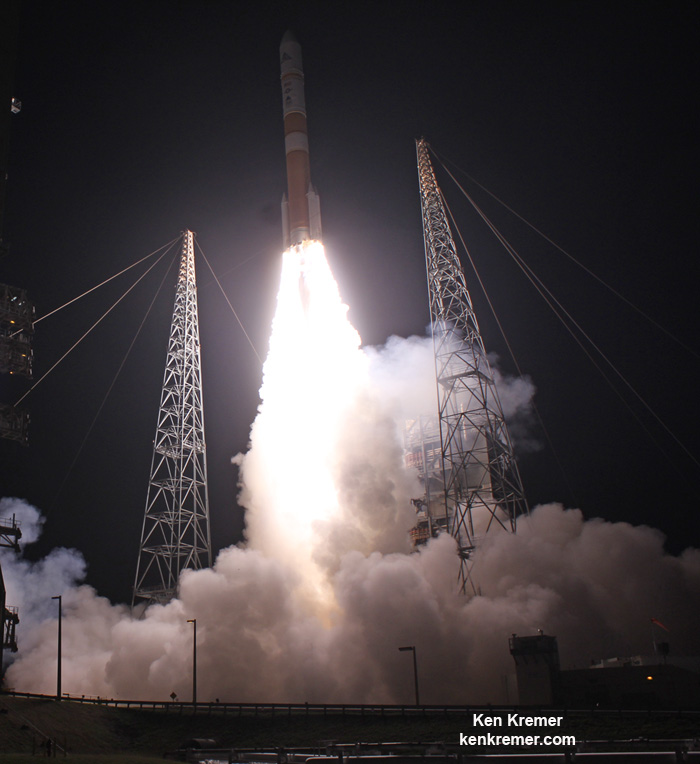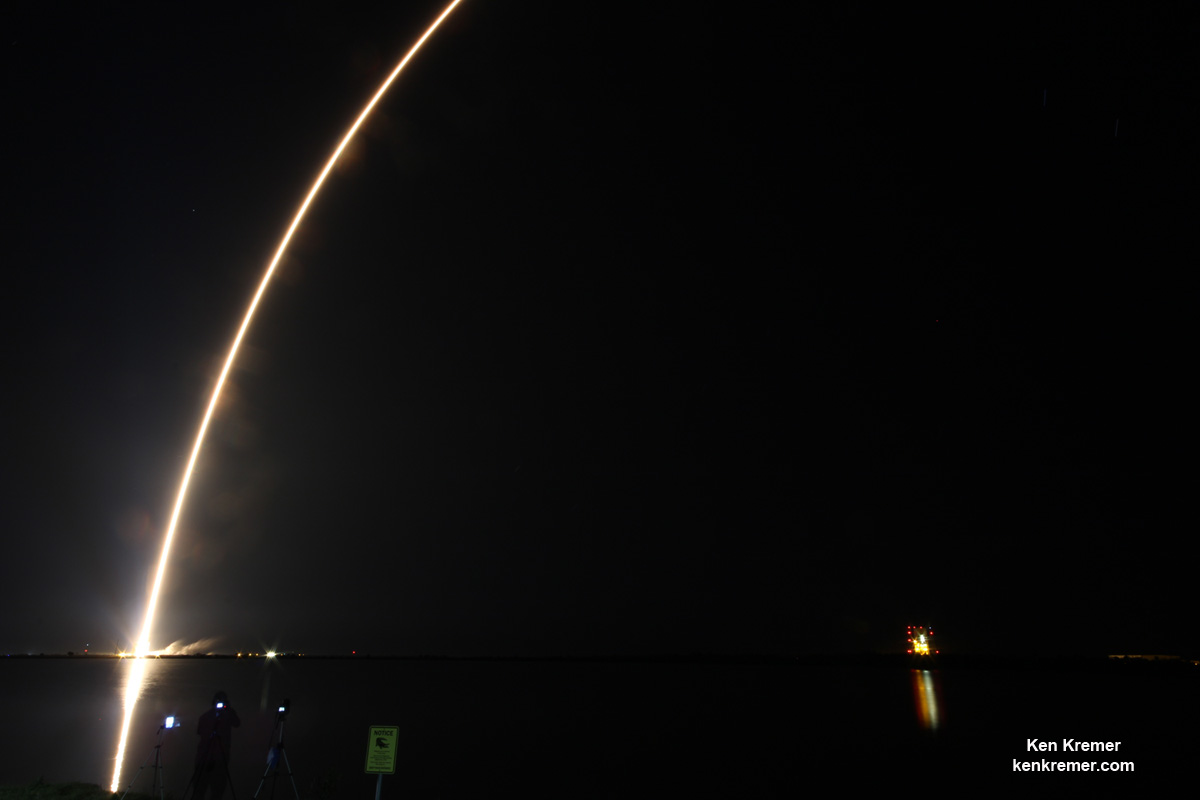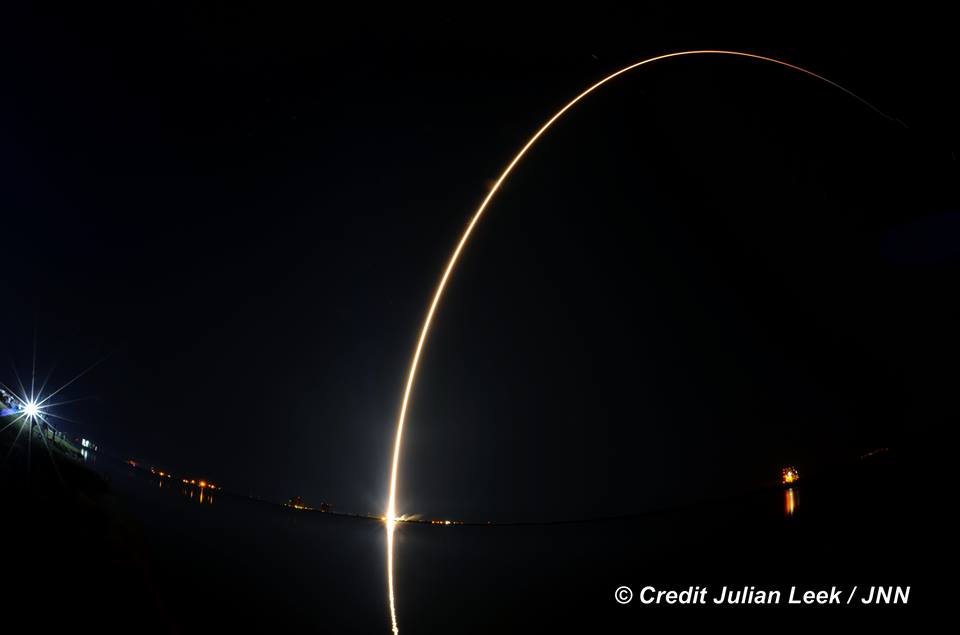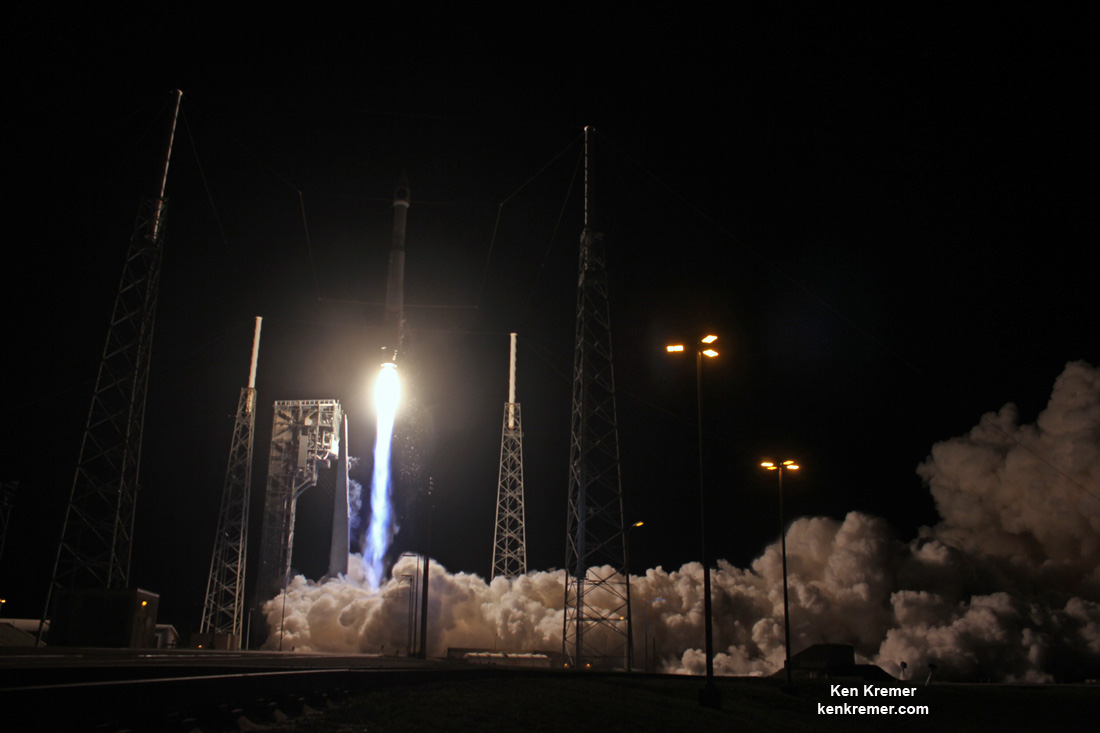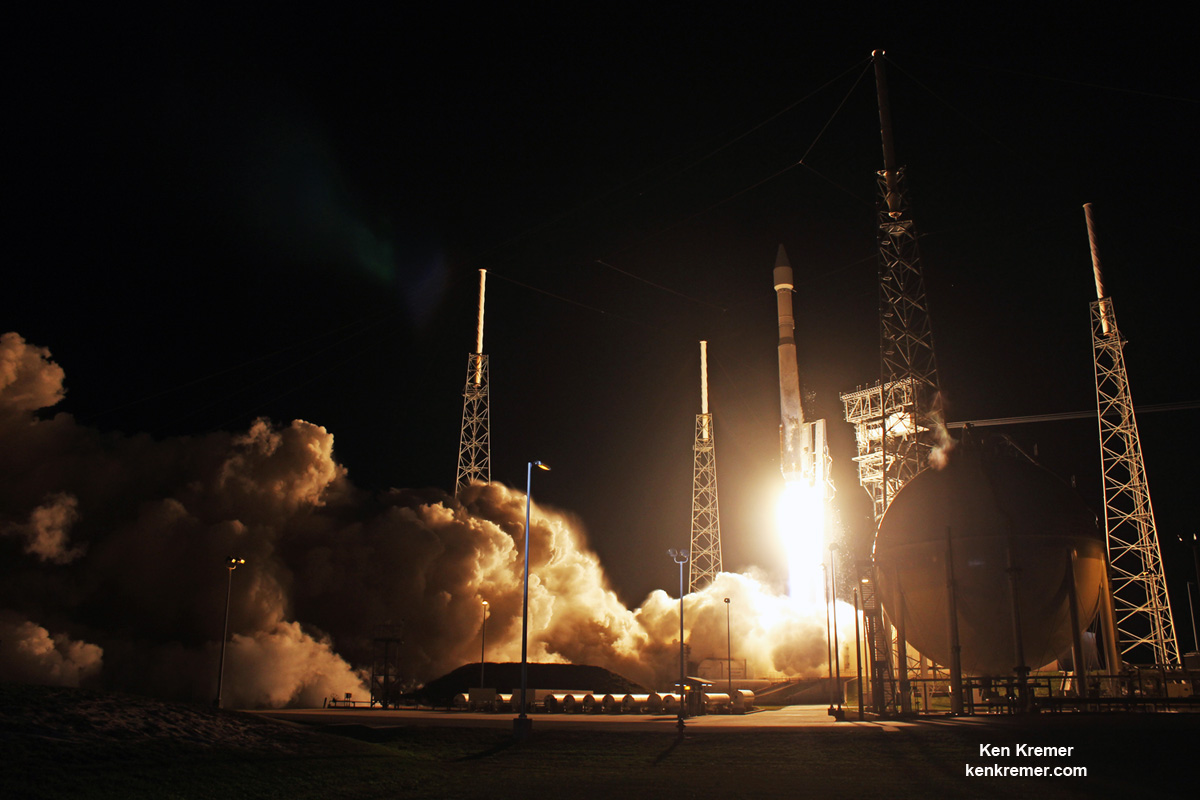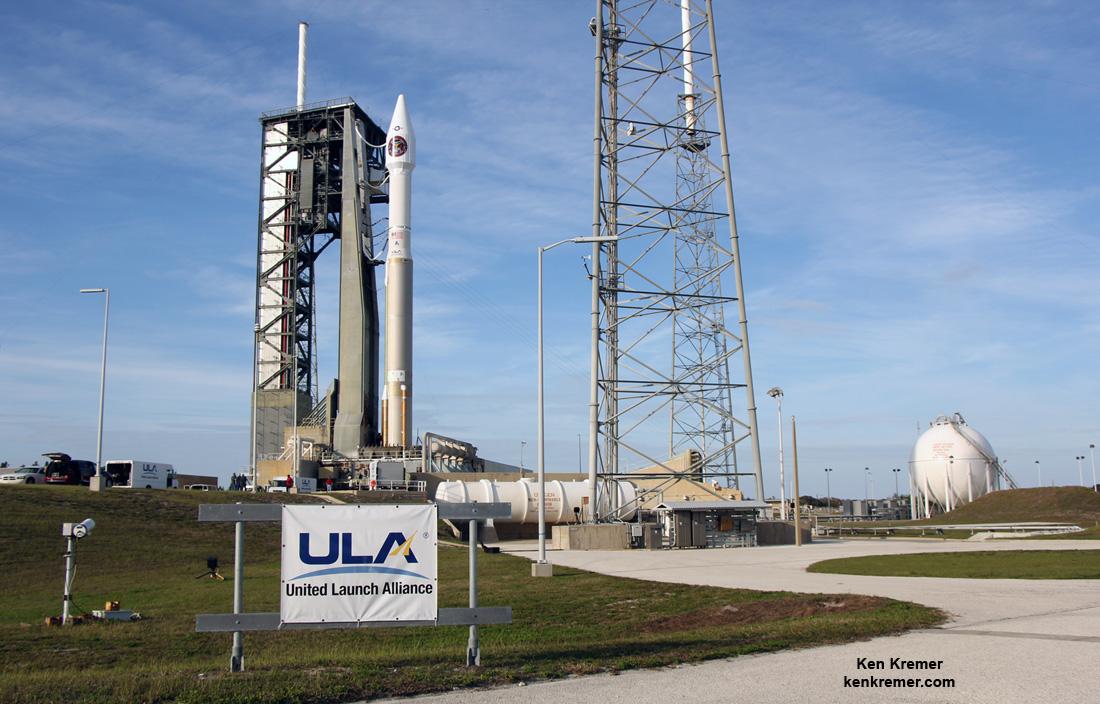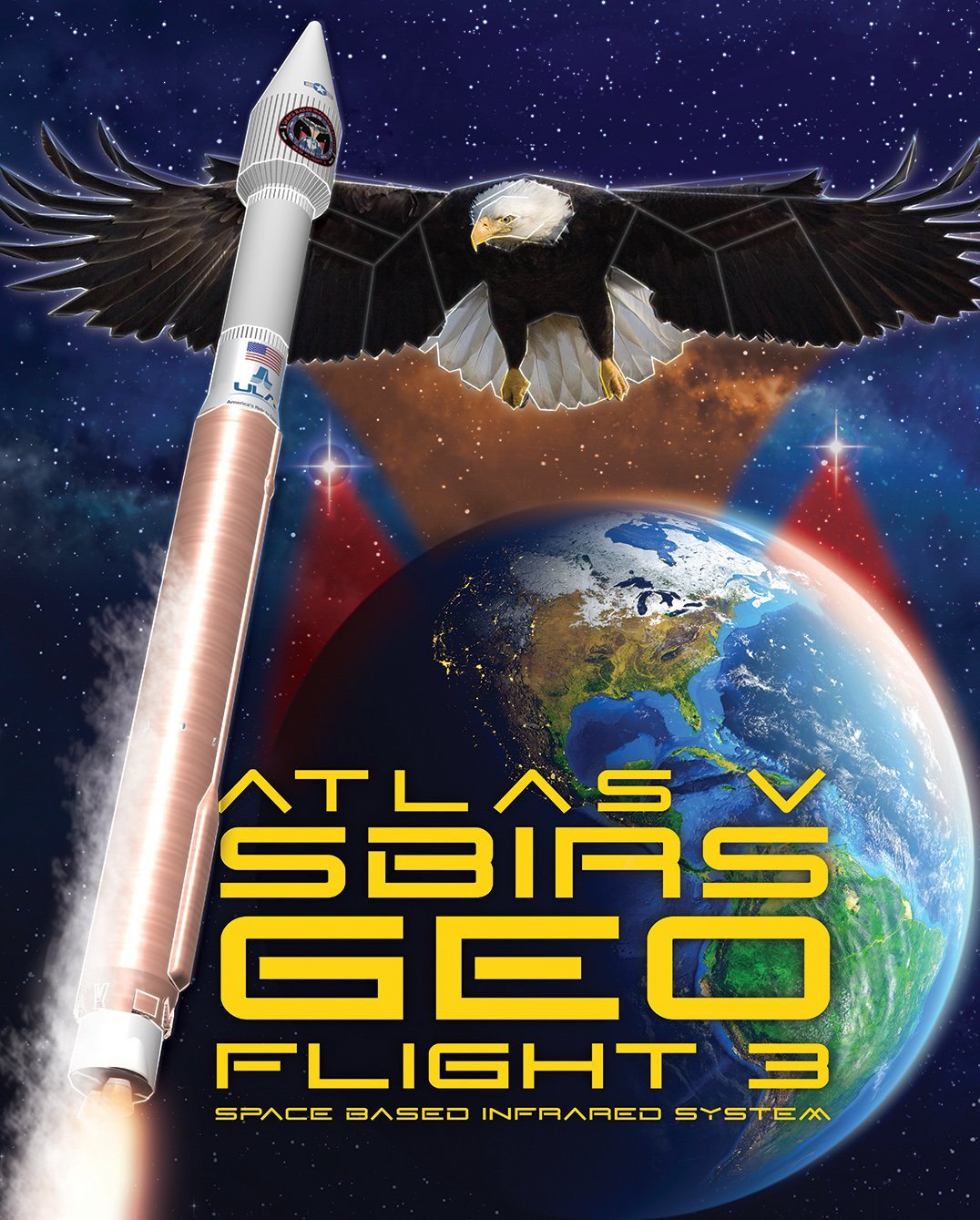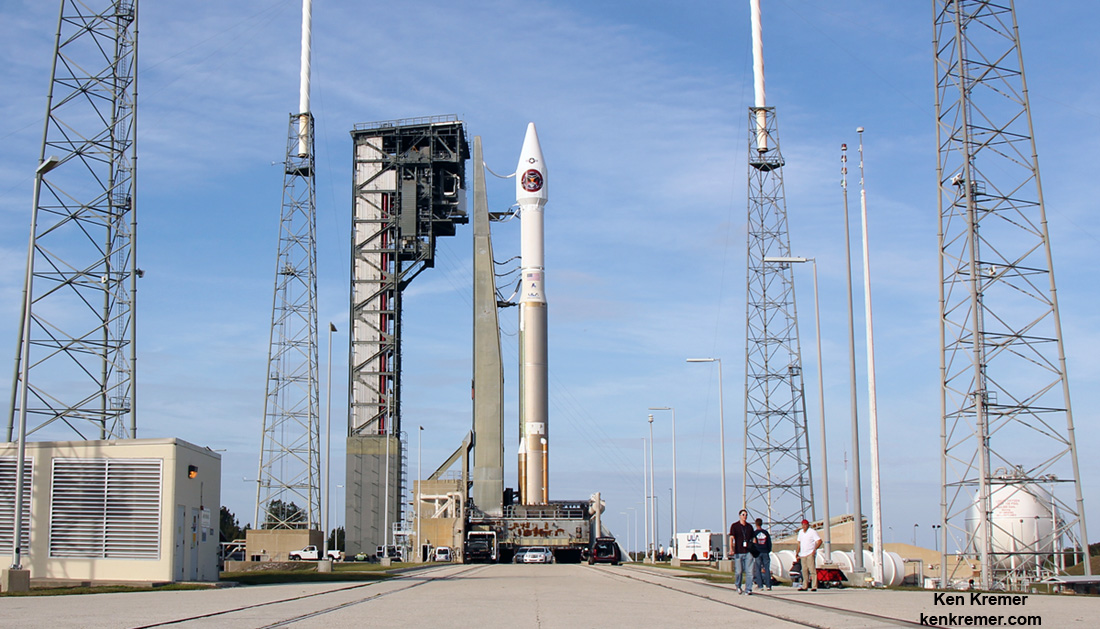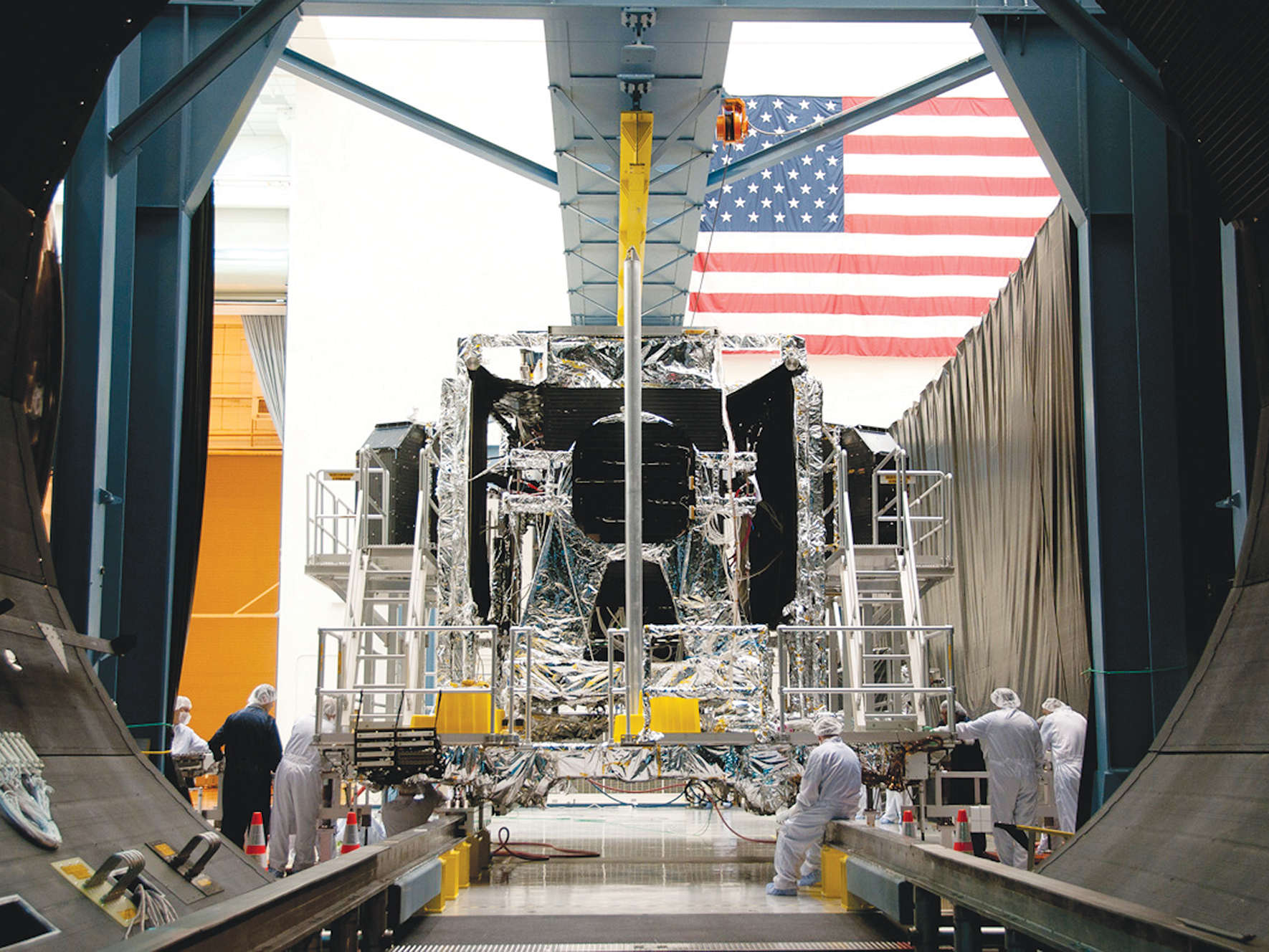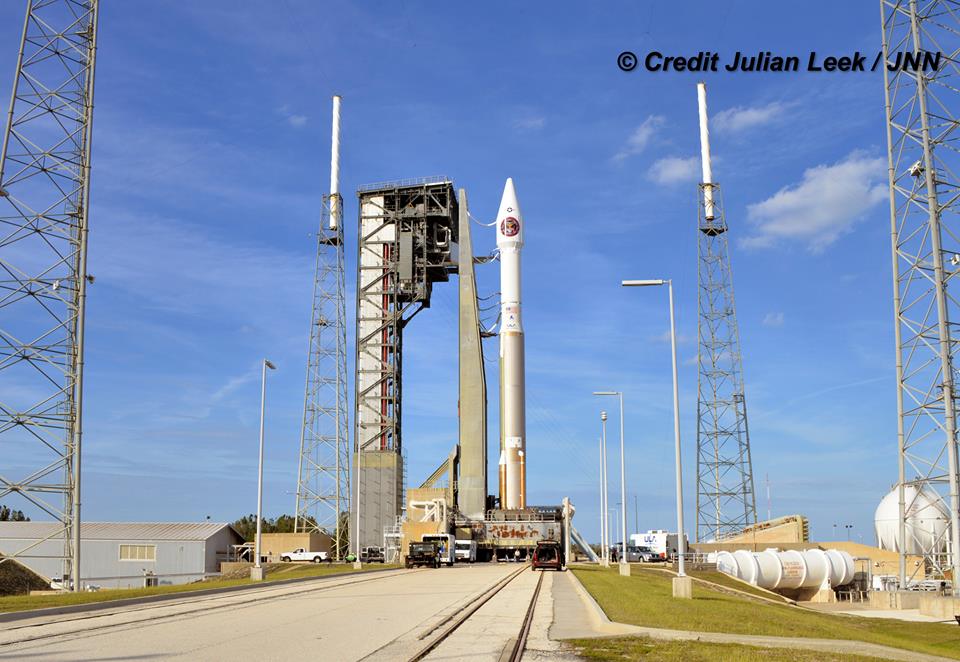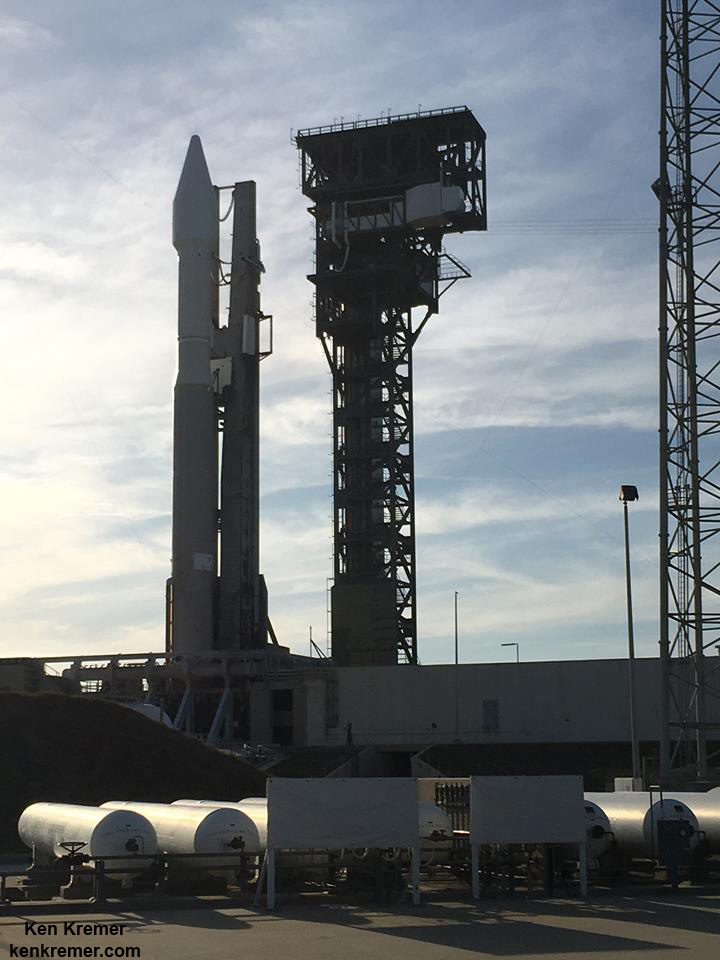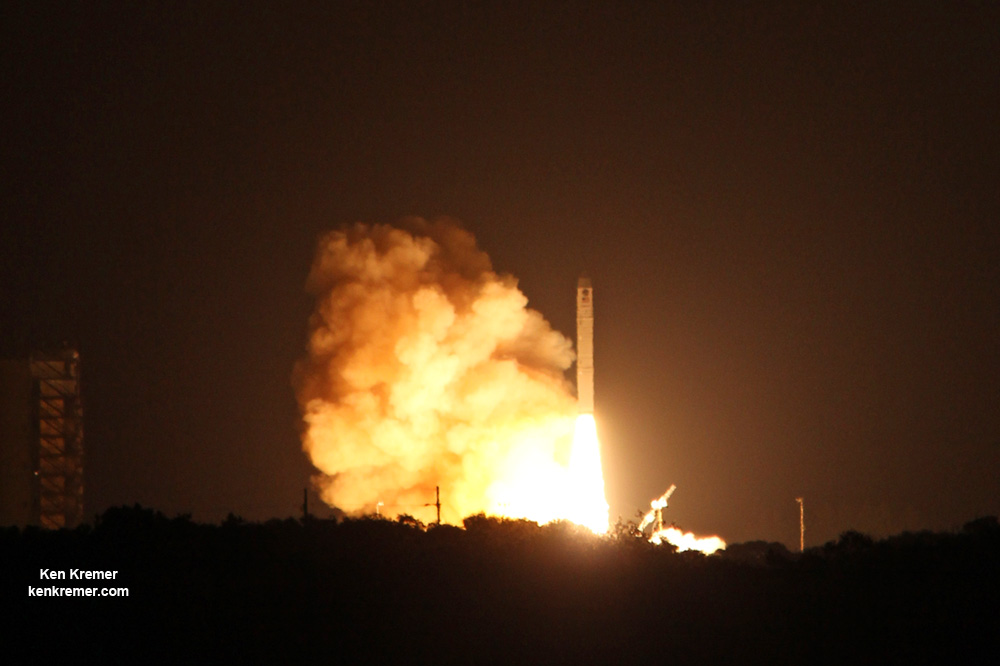
CAPE CANAVERAL AIR FORCE STATION, FL — A Cold War-era derived Peacekeeper ICBM missile formerly armed with multiple nuclear warheads and now modified as a payload orbiter successfully launched an urgently needed space situational awareness and space junk tracking satellite to equatorial orbit overnight this morning, Aug. 26, for the U.S. military from the Florida Space Coast.
Following a nearly 3 hour delay due to day long dismal weather causing locally heavy rain storms and lighting in central Florida, an Orbital ATK Minotaur IV rocket carrying the ORS-5 tracking satellite for the USAF finally lifted off in the wee hours Saturday morning, Aug. 26 at 2:04 a.m. EDT from Cape Canaveral Air Force Station in Florida.
The five stage solid fueled Minotaur IV roared rapidly off Space Launch Complex 46 (SLC-46) on a half million pounds of thrust and quickly disappeared into the clouds from the perspective of our nearby media launch viewing site on this inaugural launch of the rocket from the Cape.
Check back here to see the expanding gallery of launch photos and videos recorded by myself and space journalist colleagues!
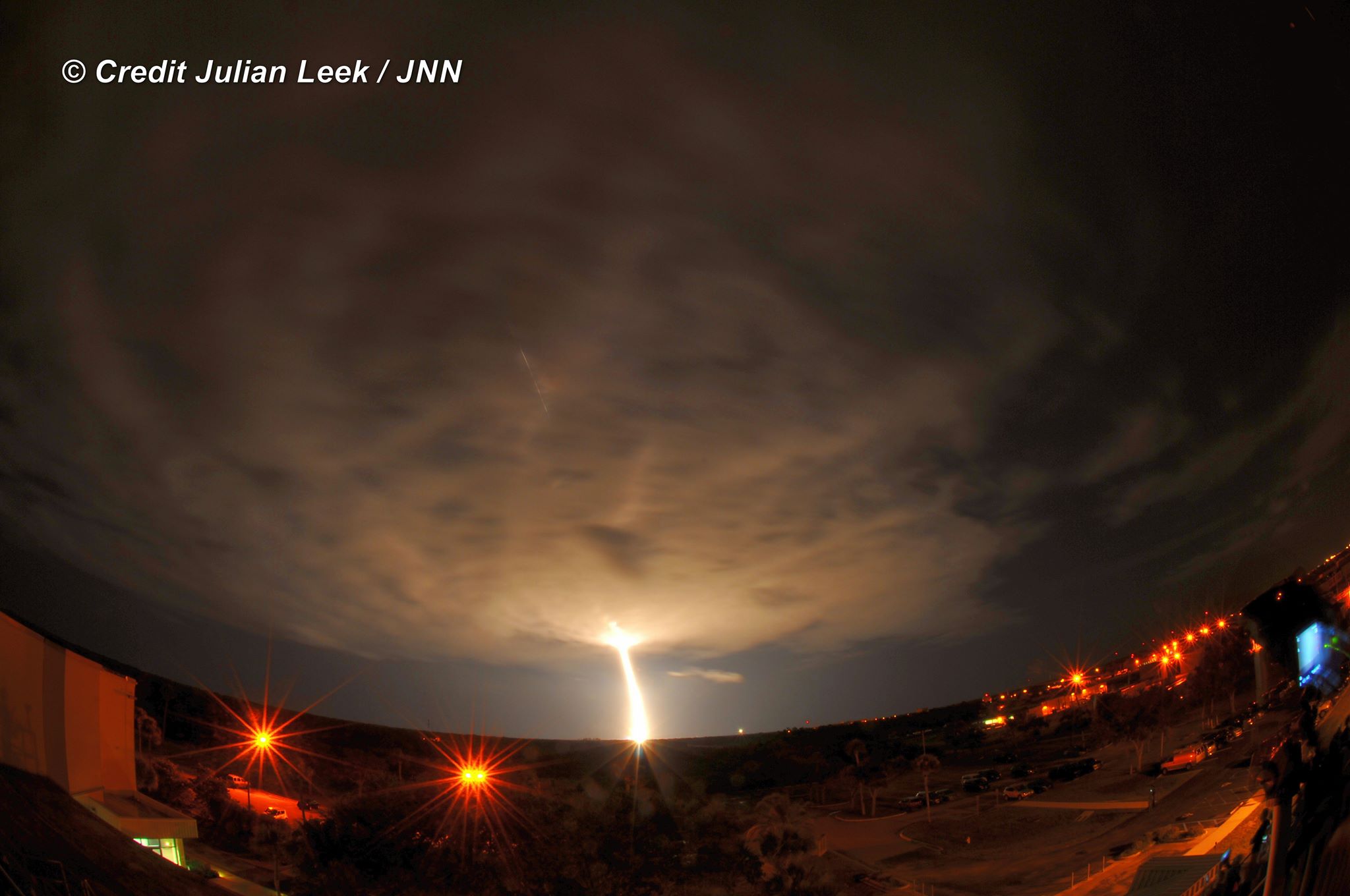
The gap filling ORS-5 space surveillance satellite is a low cost mission technology demonstration mission that will track orbiting threats for the U.S. Air Force – and offered a thrilling nighttime launch experience to those who stayed awake and braved the post midnight time slot.
The converted ICBM motor ignition produced a flash of extremely bright light that briefly turned night into day. The maiden Minotaur from the Cape gushed intensely at liftoff and left a huge exhaust trailing in its wake as it accelerated to orbit.
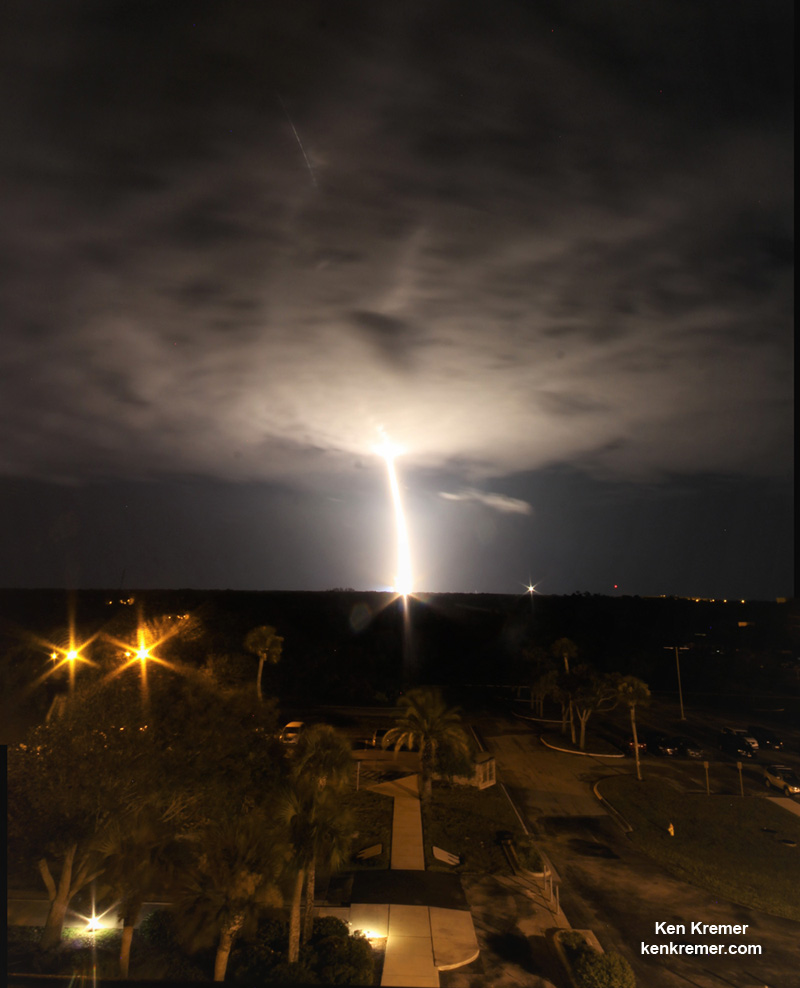
The ORS-5 is a single satellite constellation with a primary mission to provide space situational awareness of the geosynchronous orbit belt for Combatant Commanders’ urgent needs, according to Brig. Gen. Wayne Monteith, 45th Space Wing commander and mission Launch Decision Authority at Cape Canaveral Air Force Station
The ORS-5 mission, which stands for Operationally Responsive Space-5, marks the first launch of a Minotaur IV rocket from Cape Canaveral Air Force Station and the first use of SLC-46 since 1999.
SLC-46 is operated under license by Space Florida, which invested more than $6 million dollars of state funds into pad upgrades and renovations.

The ORS-5 satellite built for the USAF Operationally Responsive Space Office will provide the US military with space-based surveillance and tracking of other satellites both friend and foe as well as space debris in geosynchronous orbit, 22,236 miles above the equator.
ORS-5 is like a telescope wrapped in a satellite that will aim up to seek threats from LEO to GEO using cameras and spectrometer sensors.
Also known as SensorSat, ORS-5 is designed to scan for other satellites and debris to aid the U.S. military’s tracking of objects in geosynchronous orbit for a minimum of three years and possibly longer if its on board sensor and spacecraft systems continue functioning in a useful and productive manner.
The Minotaur IV is a five stage rocket comprised of three stages of a decommissioned Cold War-era Peacekeeper Intercontinental Ballistic Missile (ICBM) that has been modified to add two additional Orbital ATK Orion 38 solid rocket motors for the upper stages.
Approximately 28 minutes after liftoff at 2:04 a.m. EDT, the Minotaur IV deployed the ORS-5 satellite into its targeted low inclination orbit 372 miles (599 kilometers) above the earth, Orbital ATK confirmed.
“From this orbit, ORS-5 will deliver timely, reliable and accurate space situational awareness information to the United States Strategic Command through the Joint Space Operations Center.”

“This was our first Minotaur launch from Cape Canaveral Air Force Station, demonstrating the rocket’s capability to launch from all four major U.S. spaceports,” said Rich Straka, Vice President and General Manager of Orbital ATK’s Launch Vehicles Division.
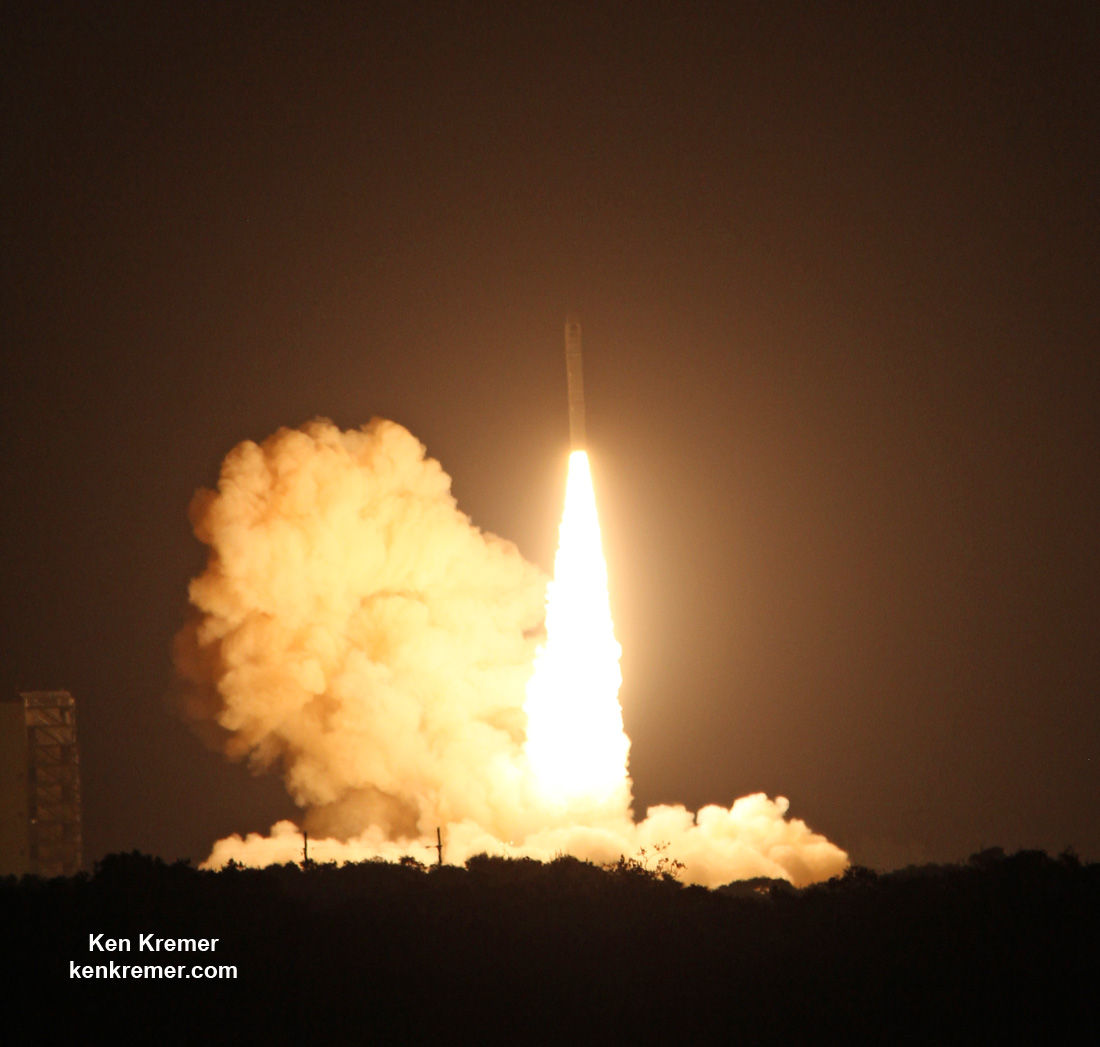
This Minotaur IV rocket is a retired Cold War-era ICBM missile once armed with nuclear warheads aimed at the former Soviet Union that can now launch satellites for purposes other than offensive nuclear war retaliation.
So on the event of a nuclear first or retaliatory strike, this is how the world could potentially end in utter destruction and nuclear catastrophy.
To get an up-close feeling of the sounds and fury watch this Minotaur IV/ORS-5 launch video compilation from colleague Jeff Seibert from our media launch viewing site from the roof of the 5th Space Launch Squadron building on Cape Canaveral Air Force Station, FL.
Video Caption: Orbital ATK launch of Minotaur ORS 5 at 2:04 a.m. EDT on Aug. 26, 2017. None of the videos are sped up, it really takes off that fast. The solid fuel Peacekeeper missile segments were repurposed to launch the ORS-5 satellite from Launch Complex 46 on CCAFS., Fl. Credit: Jeff Seibert
Overall the ORS-5 launch was the 26th blastoff in Orbital ATK’s Minotaur family of launch vehicles which enjoy a 100% success rate to date.
Today’s launch was the 6th for the Minotaur IV version.
“With a perfect track record of 26 successful launches, the Minotaur family has proven to be a valuable and reliable asset for the Department of Defense,” said Straka.
“Orbital ATK has launched nearly 100 space launch and strategic rockets for the U.S. Air Force,” said Scott Lehr, President of Orbital ATK’s Flight Systems Group. “We’re proud to be a partner they can count on.”
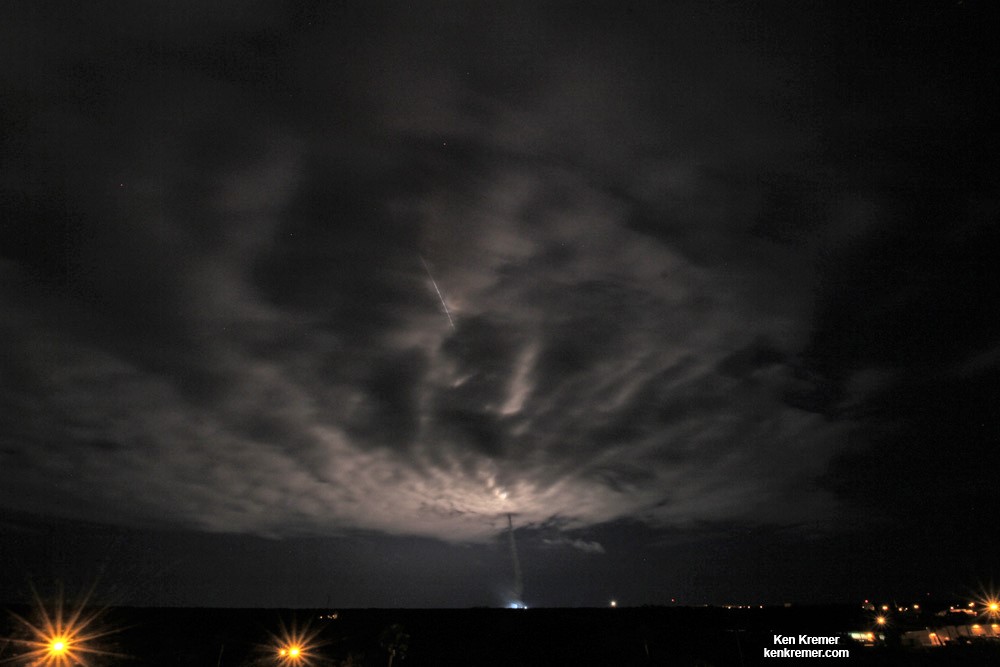
The past two weeks have been a super busy time at the Kennedy Space Center and Cape Canaveral. This morning’s post midnight launch was the third in just 11 days – and the second in a week!
A ULA Atlas V launched the NASA TDRS-M science relay satellite last Friday, Aug 18. And a SpaceX Falcon 9 launched the Dragon CRS-12 cargo resupply mission to the International Space Station (ISS) on Monday, Aug. 14.
“The ORS-5 Minotaur IV launch was the true epitome of partnership,” Gen. Monteith said.
“A collaborative effort between multiple mission partners, each group came together flawlessly to revolutionize how we work together on the Eastern Range. Teamwork is pivotal to making us the ‘World’s Premier Gateway to Space’ and I couldn’t be prouder to lead a Wing that not only has launched over a quarter of the world’s launches this year, but also three successful, launches from three different providers, in less than two weeks.”
ORS-5 was designed and built by Massachusetts Institute of Technology’s Lincoln Laboratory facility in Lexington, Massachusetts at a cost of $49 million.
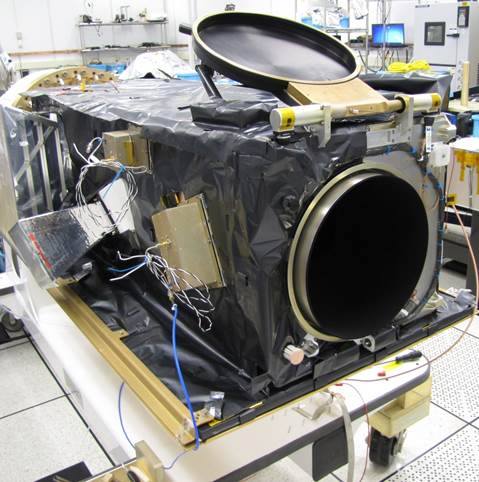
The ORS-5 or SensorSat satellite will provide the US military with space-based surveillance and tracking of other satellites both friend and foe and space debris in geosynchronous orbit 22,236 miles above the equator. Credit: MIT Lincoln Laboratory
In July 2015 the U.S. Air Force’s Operationally Responsive Space (ORS) Office awarded Orbital ATK a $23.6 million contract to launch the ORS-5 SensorSat on the Minotaur IV launch vehicle.
ORS-5/SensorSat was processed for launch and encapsulation inside the 2.3 meter diameter payload fairing at Astrotech Space Operations processing facility in Titusville, Florida.
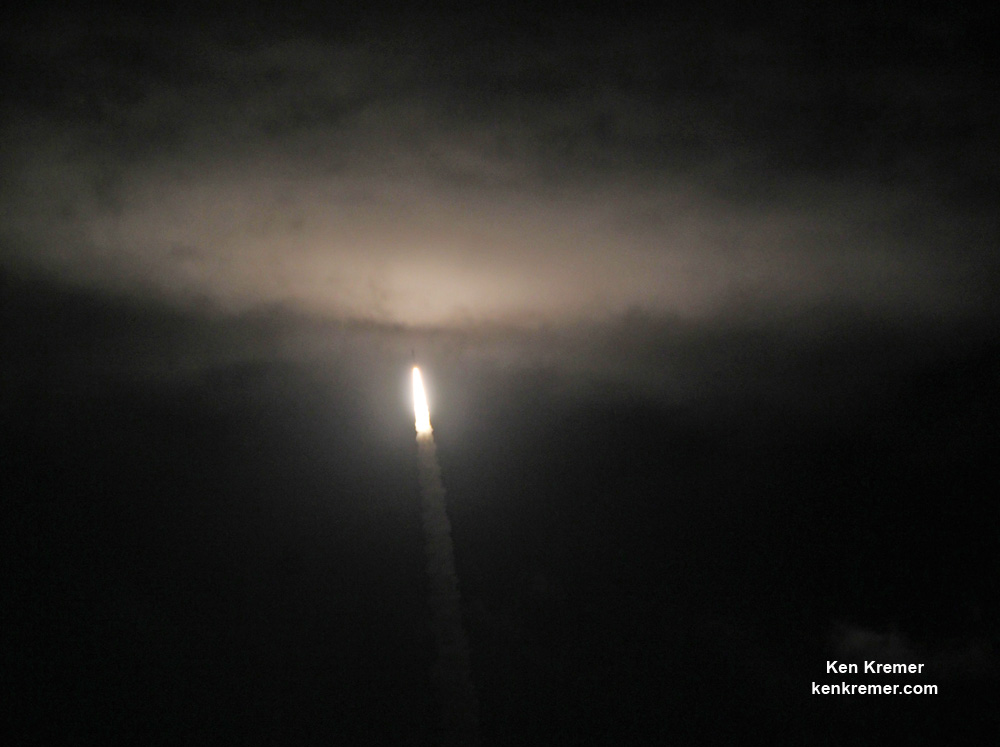
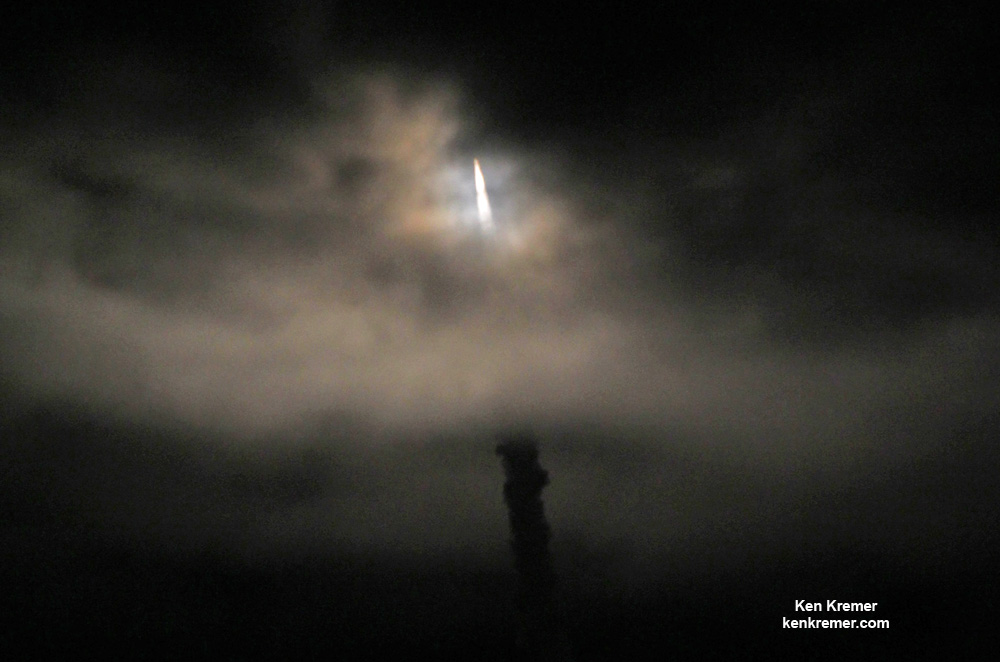
Watch for Ken’s continuing onsite Minotaur IV ORS-5, TDRS-M, CRS-12, and NASA and space mission reports direct from the Kennedy Space Center and Cape Canaveral Air Force Station, Florida.
Stay tuned here for Ken’s continuing Earth and Planetary science and human spaceflight news.
